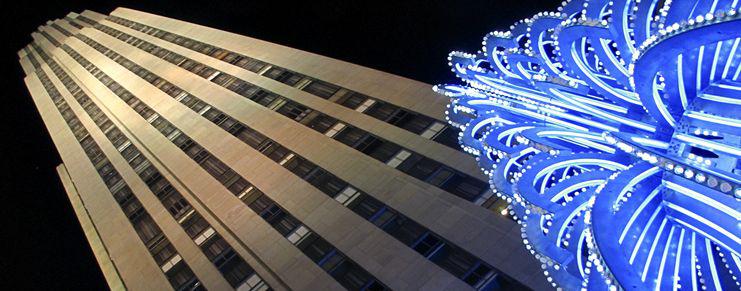
Early January 2007 in New York City. Santa Claus is leaving town again. But still on their beats underneath Prometheus are the ice skaters. The Rockefeller Center Christmas Tree comes down, the Swarovski Star is cleaned and packed for the next season: Isn’t that what you do at home, too? Here it’s just on another scale!
It’s a foggy morning, a New York morning when the cold wet creeps into everybody working outside. “Hey, it’s Pete, heard you are in town. Got some time to show up in my office, wanna talk with you about something.” Pete Dillon at that time is Rockefeller Center’s marketing director. The next day he introduces a project of public art at Rockefeller Plaza to Michael Hammers: Electric Fountain. Tim Noble and Sue Webster are the artists and among the most celebrated of their generation of the UK. “This project needs you, Mike. We need to know about feasibility and costs. We need to know if we can go ahead with it. Let’s give the producers from Art Production Fund a call and see what they have to say.” Afterwards Michael went back home, a project description and some preliminary drawings in his bag and with Noble & Webster’s contact information.
“…where there once was darkness now there is light.”

“There was only one way to do it. I went at it, had two full days of brainstorming with my whole team. We made a very basic structural analysis, worked on constructional design possibilities, did cost estimations. Concurrently the workshop started fabricating a 1 to 1 mock-up of a segment of one of the tears…including all the lighting.” Michael invited Tim and Sue to come to the Studios and have a look. Their reaction was “It’s there, it’s simply there!”
So Electric Fountain only had to be fabricated, shipped to New York and installed. And the fountain remains there happily ever after.
Is that how this fairytale ends? Oh goodness, no! Tim and Sue put it this way: “Ideas were realised, holes and empty spaces were filled, tears were shed and many hearts were broken along the way, but where there once was darkness now there is light.”
“…but keep this a secret”
If one is looking for technical solutions and systems nobody has done before-a phenomena risk managers often use to stop developing a project-nobody shares the dream anymore because nobody wants to take on the risk! Michael is a magician. He encourages, emphasizes and creates a team spirit to follow dreams. This team was ready to work 24 hours a day, 7 days a week, for months. Michael says, “The crew became bound together, everybody could see the Fountain’s light at the end of the tunnel. Although at the beginning there wasn’t even a tunnel…but keep this a secret.”
Just before the fabrication had to get kicked-off, New York gallerist Jeffrey Deitch came on board, sharing this spirit and guaranteeing the full budget. “Work hard and be true and honest and you will be rewarded” is Michael’s conviction. That is just how Jeffrey Deitch and Michael Hammers started personally respecting each other: “Our gallery had a great collaboration with Michael Hammers in the design and fabrication of Tim Noble and Sue Webster’s Electric Fountain, which the gallery helped to produce.”, is Jeffrey Deitch’s statement.
Electric Fountain creates a hypnotic experience!
 It took 9000 working hours to bring Electric Fountain into being with its total weight of 27 tons, a diameter and height of about 35 feet each. On the one hand, Electric Fountain is a piece of art, but on the other hand also a masterpiece of technical inventiveness, engineering and metalwork. The whole construction and electrical system got public approval and certification. The “amusement-lights” were especially designed by LED’s with the lowest possible power consumption of 0.1 Watts. When for the first time the low voltage LED system were running together with the high voltage neon during the test-installation in Cologne no electrical specialist was able to guarantee that both systems would run without conflict interaction.
It took 9000 working hours to bring Electric Fountain into being with its total weight of 27 tons, a diameter and height of about 35 feet each. On the one hand, Electric Fountain is a piece of art, but on the other hand also a masterpiece of technical inventiveness, engineering and metalwork. The whole construction and electrical system got public approval and certification. The “amusement-lights” were especially designed by LED’s with the lowest possible power consumption of 0.1 Watts. When for the first time the low voltage LED system were running together with the high voltage neon during the test-installation in Cologne no electrical specialist was able to guarantee that both systems would run without conflict interaction.
But it worked.
Electric Fountain represents a modern take on the world’s oldest form of public art, the fountain. Tim Noble and Sue Webster simultaneously reference iconic pop culture symbols, and historical fountains built in civic spaces. And honestly! The design and sequencing of the work creates an hypnotic experience!















